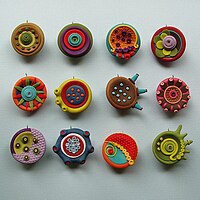Sculpey
This article needs additional citations for verification. (April 2013) |


Sculpey (often misspelled as Sculpy) is the brand name for a type of polymer clay that can be molded and put into a conventional oven to harden, as opposed to typical modeling clays, which require a much hotter oven, such as a kiln. Until it is baked, Sculpey has a consistency somewhat like Plasticine. It is sold in many colors, though it can also be painted once fired. It has become popular with modeling artists. It is also sometimes used for claymation.[1]
History
Sculpey is a brand of polymer clay made by Polyform Products in the United States. Sculpey was first created in the early 1960s. The original idea was to use the clay as a thermal transfer compound; this would conduct heat away from the cores of electrical transformers. However, the compound was not successful for this use so it was pushed to the side for a while. In the late 1960s it was then discovered that this compound could be molded, baked, sanded, drilled, carved and painted. This was a perfect medium for the craft industry. The clay was marketed directly to people at craft shows, street fairs and demonstrations in small art stores.
Sculpey closely resembles Fimo, another brand of polymer clay. Sculpey is a less rigid composition which better suits modeling, while Fimo is better suited for twisting into cane and bead making because the colors do not blend together as readily. The plasticity is controlled by the amount of oil suspending the polymers in the "clay".
Techniques
Many techniques exist for working with polymer clay.
Sculpture involves creating detailed representations of objects.
Caning is a technique borrowed from glass artisans, who would know it as millefiori, meaning "a thousand flowers". It involves making a picture from thick pieces of polymer clay, which is then extruded so the picture becomes smaller and it becomes thicker, until it is longer than it is high. The cane has the original picture running right through it, although smaller. It can then be sliced, with the slices used to cover other objects or blobs of scrap polymer clay.[2]
Marbling is one of the simplest techniques used with polymer clay. It involves mixing different colors of polymer clay together to form a pattern. As the clay is mixed, the pattern becomes smaller and smaller, until the two colors are completely blended.
Mokume-Gane is a technique borrowed from metalworking. It involves placing several sheets of clay on top of each other and then pushing an object through it.
